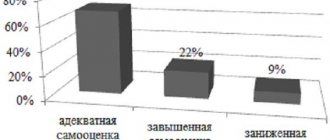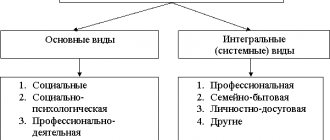The essence of the adaptation process for first-graders
School poses a large number of new tasks for the child, which require the mobilization of his physical and intellectual strength.
A first-grader needs to get used to the new conditions that have arisen in his life and adapt to them. We are talking about adaptation to school - the most stressful period in the first year of study. It occurs at the social, physiological and psychological level. The adaptation period for each child occurs individually. Its duration can range from three weeks to six months. It is important to monitor the dynamics of the adaptation process, identify the causes of emerging maladjustment and carry out the necessary correction of identified deviations in the course of “adjusting” a first-grader to school life.
| Factors of social adaptation | Factors of physiological adaptation | Factors of psychological adaptation |
|
|
|
Diagnostic criteria for ADHD according to the DSM-IV classification of disorders (1994)
To make a diagnosis, at least 6 of the following symptoms of inattention, hyperactivity and impulsivity must be present, which have persisted for at least 6 months and are severe enough to indicate insufficient adaptation and failure to meet normal age characteristics.
Table 1
Distribution of surveyed primary school students
| Duration of schooling, years | Age, years | Number of people examined | ||
| boys | girls | Total | ||
| 1 | 7 | 107 | 91 | 198 |
| 2 | 8 | 93 | 73 | 166 |
| 3-4 | 9-10 | 100 | 73 | 173 |
| Total: | 300 | 237 | 537 | |
Basic diagnostic issues
Diagnosing the adaptation of first-graders involves conducting an in-depth individual examination. It is aimed at obtaining information about the qualitative indicators of the main necessary changes that must occur in all areas of the child’s life and activity.
The main goal of diagnosis is to identify children who have difficulty adapting and need professional help. Based on the results of the study, individual development trajectories of schoolchildren should be determined and recommendations should be developed for teachers and parents to support children in the process of their school adaptation.
Diagnostics are initiated by the school administration in order to obtain general information about the level of adaptation of all first-graders. This type of activity must be recorded in the school’s work plan for the academic year. The school psychologist is directly involved in conducting research and processing data in close collaboration with the class teacher of first-graders.
Diagnostics is carried out in several stages.
- Observation - takes place during the first month of school to detect peculiarities in the child’s behavior during lessons and breaks.
- The survey is carried out from September 15 to 30. Aimed at establishing:
- the level of mental development of first-graders, identifying children who are lagging behind the age norm;
- the degree of formation of motives for learning, identification of the leading motive;
- stability of the student’s emotional state, the presence of negative or positive emotions that the child experiences in different educational situations;
- level of school anxiety, analysis of factors that cause discomfort, tension, and fear in a first-grader.
- Drawing up individual conclusions - after the survey, final processing of the data obtained is carried out, on the basis of which:
- children at risk are identified;
- recommendations are developed for teachers and parents.
The basis for drawing up such a conclusion should be a summary table with diagnostic results. It may look like this.
- Familiarization of participants in the educational process with the results of diagnostics of adaptation of first-graders - the final conclusions are discussed during:
- small teachers' council or consultation (most often they are held during the autumn holidays);
- individual consultations;
- parent meeting.
- The development of individual programs for working with children with signs of maladjustment occurs in close cooperation with all interested parties. This work must be completed by the end of the first quarter. The program must include:
- group classes;
- individual psychological and pedagogical support;
- individual forms of work aimed at solving specific problems.
You can use these recommendations from R.V. Ovcharova.
- Implementation of individual programs takes 1–4 months.
- Repeated diagnostics should be carried out at the end of the school year (April - May) to obtain final data.
- The final stage is necessary to compare the starting and final indicators. At this stage, the dynamics of the child’s development are analyzed and the effectiveness of the implementation of the recommendations and programs developed is established.
Based on the information provided, the psychologist must draw up a plan for diagnosing the level of adaptation of first-graders, specifying the indicated areas of activity. It may have this form:
| Kind of activity | Goal and tasks | The content of the work | Information summary form | Responsible | Deadlines |
To obtain complete and reliable information about each child during the diagnostic process, it is also necessary to carry out:
- parent survey;
- interviewing teachers;
- study of children's medical records.
The main direction of diagnostic activity is conducting surveys and testing of first-graders using various techniques. It can be carried out both individually and in group form. Typically, it takes 15–20 minutes to examine one child.
Approaches to solving the problem
In pedagogy and psychology at the moment there are three approaches to resolving the situation:
- A child’s school maladaptation is a mental personality disorder and requires psychiatric treatment.
- School maladaptation as a pedagogical phenomenon, i.e. the main provoking factor in its development is the relationship with teachers, their style of teaching and education. Accordingly, corrections should be handled exclusively by them.
- This is a complex socio-psychological process of the formation of a conflict between the child’s personality and the demands of the school. The solution is an integrated approach to solving the problem.
Despite the logic and scientific validity of the latter direction, this remains an open problem in psychology, causing a lot of controversy and ambiguity in the ways of solving it.
Observation
The most common diagnostic method is observation. The most commonly used method is sample observation. During its implementation, only those features of the child’s behavior are recorded that distinguish him from the general mass of first-graders. Observation is carried out simultaneously for all children in the class. Basic requirements for organizing surveillance:
- presence of an observation scheme;
- systematic;
- objectivity.
Observation should also include:
- analysis of the child’s progress;
- viewing notebooks;
- listening to oral responses;
- analysis of existing interpersonal relationships.
As a result of observations, the main seven components are assessed (on a 5-point scale):
- educational activity;
- mastering program materials;
- behavior in lessons;
- behavior during breaks;
- relationships with classmates;
- relationship with the teacher;
- emotions.
The corresponding scores and conclusions must be entered into the school adaptation card.
The total points can be interpreted as follows:
- 35 – 28 – high level of adaptation;
- 27 – 21 – average;
- 20 or less is low.
To conduct observations during the adaptation period, you can use Stott's map , which provides for the study of asociality, infantility, subordination, activity and uncertainty.
Factor Asociality, Infantility, Subordination, Activity, Uncertainty - see here.
With this method, the overall score is not displayed, but each criterion is assessed separately. After this, groups of children with the highest (above 65%) scores for each factor are determined.
Questionnaire for teachers
| № | Anxiety indicators | Often (2b) | Sometimes (1b) | Never (0b) |
| 1. | The child is afraid to answer at the blackboard | |||
| 2. | Starts to stutter while answering | |||
| 3. | Blushes easily when addressed by teacher | |||
| 4. | Not sure of the correctness of my answers or actions | |||
| 5. | Reacts with panic to failures in school | |||
| 6. | Very afraid of making a mistake when answering | |||
| 7. | Feels that he is treated poorly in class | |||
| 8. | In class he bites his nails, sucks his fingers, twirls his hair. | |||
| 9. | Makes restless movements with fingers while answering |
Test "Houses"
Another method for diagnosing first-graders’ adaptation to school is the “Houses” test. It is carried out to determine:
- value orientations;
- social emotions;
- personal relationships.
This test is a color association study. The author of the test is O.A. Orekhova. To carry it out you need to prepare:
- questionnaire;
- 8 pencils (black, grey, brown, purple, blue, green, yellow, red).
Pencils should not look different from each other.
For the study, you need to invite a group of children (10-15 people) and seat them separately from each other. It is imperative that the teacher is not present in the classroom during the diagnosis. Children must complete three tasks.
Exercise 1.
There is a picture of a house, to which a path of 8 rectangles leads. First graders are asked to color them in order, and each color can only be used once. First you need to choose the color you like best and decorate the first rectangle. Next, take the color that you like best among the remaining ones. The last rectangle will be painted with the ugliest color, in the child’s opinion.
Task 2.
Children will color a picture that shows a street with several houses. The psychologist should explain that different feelings live in these houses and children need to choose for each of them the color with which they are associated when naming such words: happiness, grief, justice, resentment, friendship, quarrel, kindness, anger, boredom, admiration .
In this task, the same color can be used several times. If schoolchildren do not understand the meaning of any of the named words, then the psychologist explains it.
Task 3.
The picture used is the same as in the previous task. Now the children must decorate the houses in a color that symbolizes their inhabitants. The soul of a child lives in the first house. The inhabitants of houses 2-9 are responsible for his mood in such situations:
- when he goes to school;
- in a reading lesson;
- in a writing lesson;
- in a math lesson;
- when communicating with the teacher;
- when communicating with classmates;
- when he is at home;
- when doing homework.
In the tenth house, the child must himself accommodate any “colored” tenant, who will signify his special condition in a situation that is important to him personally. After completing this task, each first grader must tell the psychologist what exactly this tenth house means to him (it is better to do this so that the other children do not hear), and he makes a corresponding note on the questionnaire.
When summing up the results of this diagnosis of adaptation of first-graders, the psychologist should focus on the following numbering of colors: 1 - blue, 2 - green, 3 - red, 4 - yellow, 5 - purple, 6 - brown, 7 - black, 0 - gray.
To avoid having to do such complex calculations yourself, you can try to find a special program on the Internet designed to process the results of this test.
Impulsiveness
1. Often answers questions without thinking, without listening to them completely.
2. Usually has difficulty waiting his turn in various situations.
3. Often interferes with others, pesters others (for example, interferes in conversations or games).
Some symptoms of impulsivity, hyperactivity and inattention begin to cause concern when a child reaches 7 years of age.
Problems caused by the symptoms listed above occur in two or more environments (for example, school and home).
There is strong evidence of clinically significant impairments in social interactions or school learning.
According to the DSM-IV classification, in cases of complete compliance with the clinical picture observed over the last 6 months simultaneously with all the listed criteria for all signs, a diagnosis of a combined form of ADHD is made.
If over the past 6 months there has been complete compliance of symptoms with the criteria for the “Inattention” trait, with partial compliance with the criteria for the “Hyperactivity” and “Impulsivity” traits, the diagnostic formulation of ADHD with predominant attention disorders is used.
If over the past 6 months there has been complete compliance of symptoms with the criteria for the signs “Hyperactivity” and “Impulsivity” with partial compliance with the criteria for the trait “Inattention”, then the diagnosis states: ADHD with a predominance of hyperactivity and impulsivity.
If there were appropriate indications, children with detected pathology were sent for additional consultations (pediatrician, ophthalmologist, otolaryngologist, family psychologist, psychiatrist) and studies (EEG, electroneuromyography, CT).
Questionnaire “Level of School Motivation”
To determine the level of adaptation of first-graders to school, you can also use diagnostics of the child’s motivational sphere according to N.G. Luskanova . It is conducted in the form of a short questionnaire, the questions of which are read aloud, and children must choose the appropriate answer.
Read more.
When processing the results, all answers must be entered into a table that contains a special key for determining the number of points received.
The calculation results should be interpreted as follows.
This technique allows not only to identify the level of adaptation of schoolchildren, but also to identify the reasons leading to a decrease in the child’s motivation to attend school.
Causes
There is no consensus in educational and developmental psychology to explain the reasons for the development of school maladaptation in students. Some believe that the only provoking factor is an insoluble conflict between the demands of the educational environment and the psychophysical characteristics of the child. Others name multiple preconditions that lead to the development of this problem.
Most often, the following circumstances become psychotraumatic factors (prerequisites):
- inability to master school material due to disturbances in analyzers, physical defects, problems of intellectual and psychomotor development, limited mental abilities (the consequences of the influence of these factors are called didactogenies);
- heredity: congenital vulnerability of the central nervous system;
- teacher influence, for example, excessive demands, injustice, having favorites, authoritarian style, etc. (consequences - didascalogeny);
- family influence: dysfunctional environment, lack of attention from parents, parenting style, etc.;
- low or high self-esteem;
- poor relationships with peers, the position of an outcast or unrecognized in the class;
- any mental trauma and personality disorders.
Most often, a violation of the adaptation process develops in a child under the influence of a whole range of reasons. Among them there are psychophysiological prerequisites:
- school immaturity - unpreparedness for stress;
- insufficient development of voluntariness - inability to adhere to discipline, rules of behavior, basic instructions for actions;
- unformed school type of thinking;
- problems with speech or hearing;
- low level of cognition;
- lack of internal position.
Since the factors of school maladjustment lie in the sphere of not only the psyche, but also physiology, their elimination should be comprehensively addressed not only by psychologists and teachers, but also by doctors, and with the deep interest and support of parents.
“Ladder” technique
To determine the level of self-esteem of a child when diagnosing the adaptation of first-graders to school, it is recommended to use the “Ladder” technique. To carry it out, you need to prepare a drawing of a staircase with numbered steps.
The child is invited to familiarize himself with this arrangement of schoolchildren on the steps:
- 1 - the nicest guys;
- 2 and 3 - good;
- on 4 - neither good nor bad;
- 5 and 6 - bad;
- at 7 - the worst.
The first grader must indicate the step on which, in his opinion, he himself should be. You can draw a circle on this step or put another mark. There is no need to focus on the numbering of steps when conducting the test. It is desirable that the same ladder be drawn on the board, and the psychologist would simply point to each step and explain its meaning, and the children would simply correlate it with their image.
The results are assessed as follows:
- 1 - inflated self-esteem;
- 2 and 3 - adequate;
- 4 - underestimated;
- 5 and 6 - bad;
- 7 - sharply underestimated.
This technique can be replaced with a similar test “Mugs” .
Also, to determine the level of self-esteem of a first-grader, you can use the method of studying adaptation the Luscher method , which is carried out using special forms.
Anxiety test
To determine the level of anxiety in a first-grader, it is proposed to conduct a survey of teachers and parents, more details.
When summing up the results, it is necessary to calculate the total score, which sums up the results of both surveys.
a “Good-Bad Chart” test to determine a child’s emotional problems
There is another projective method for diagnosing school anxiety that is similar in its direction (A.M. Prikhozhan).











